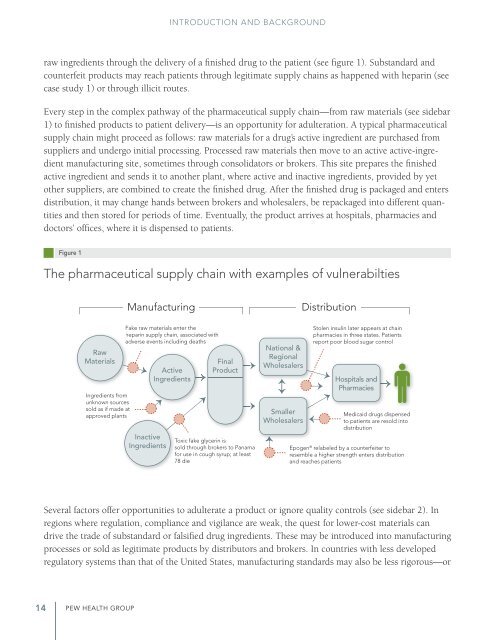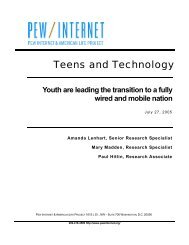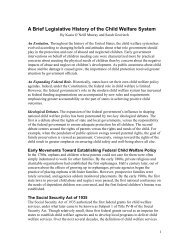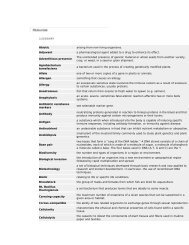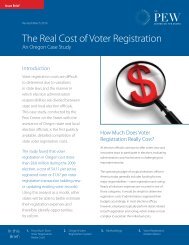After Heparin: - The Pew Charitable Trusts
After Heparin: - The Pew Charitable Trusts
After Heparin: - The Pew Charitable Trusts
Create successful ePaper yourself
Turn your PDF publications into a flip-book with our unique Google optimized e-Paper software.
INTRODUCTION AND BACKGROUND<br />
raw ingredients through the delivery of a finished drug to the patient (see figure 1). Substandard and<br />
counterfeit products may reach patients through legitimate supply chains as happened with heparin (see<br />
case study 1) or through illicit routes.<br />
Every step in the complex pathway of the pharmaceutical supply chain—from raw materials (see sidebar<br />
1) to finished products to patient delivery—is an opportunity for adulteration. A typical pharmaceutical<br />
supply chain might proceed as follows: raw materials for a drug’s active ingredient are purchased from<br />
suppliers and undergo initial processing. Processed raw materials then move to an active active-ingredient<br />
manufacturing site, sometimes through consolidators or brokers. This site prepares the finished<br />
active ingredient and sends it to another plant, where active and inactive ingredients, provided by yet<br />
other suppliers, are combined to create the finished drug. <strong>After</strong> the finished drug is packaged and enters<br />
distribution, it may change hands between brokers and wholesalers, be repackaged into different quantities<br />
and then stored for periods of time. Eventually, the product arrives at hospitals, pharmacies and<br />
doctors’ offices, where it is dispensed to patients.<br />
GMP Warning Letters By Category<br />
Figure 1<br />
<strong>The</strong> pharmaceutical supply chain with examples of vulnerabilties<br />
Manufacturing<br />
Distribution<br />
Raw<br />
Materials<br />
Ingredients from<br />
unknown sources<br />
sold as if made at<br />
approved plants<br />
Fake raw materials enter the<br />
heparin supply chain, associated with<br />
adverse events including deaths<br />
Inactive<br />
Ingredients<br />
Active<br />
Ingredients<br />
Final<br />
Product<br />
Toxic fake glycerin is<br />
sold through brokers to Panama<br />
for use in cough syrup; at least<br />
78 die<br />
National &<br />
Regional<br />
Wholesalers<br />
Smaller<br />
Wholesalers<br />
Stolen insulin later appears at chain<br />
pharmacies in three states. Patients<br />
report poor blood sugar control<br />
Hospitals and<br />
Pharmacies<br />
Medicaid drugs dispensed<br />
to patients are resold into<br />
distribution<br />
Epogen ® relabeled by a counterfeiter to<br />
resemble a higher strength enters distribution<br />
and reaches patients<br />
Several factors offer opportunities to adulterate a product or ignore quality controls (see sidebar 2). In<br />
regions where regulation, compliance and vigilance are weak, the quest for lower-cost materials can<br />
drive the trade of substandard or falsified drug ingredients. <strong>The</strong>se may be introduced into manufacturing<br />
processes or sold as legitimate products by distributors and brokers. In countries with less developed<br />
regulatory systems than that of the United States, manufacturing standards may also be less rigorous—or<br />
14<br />
<strong>Pew</strong> Health Group


